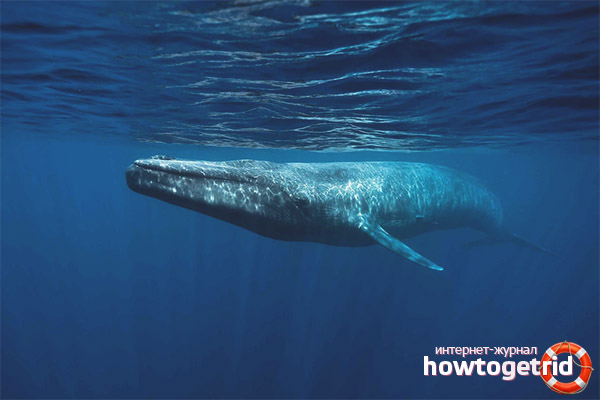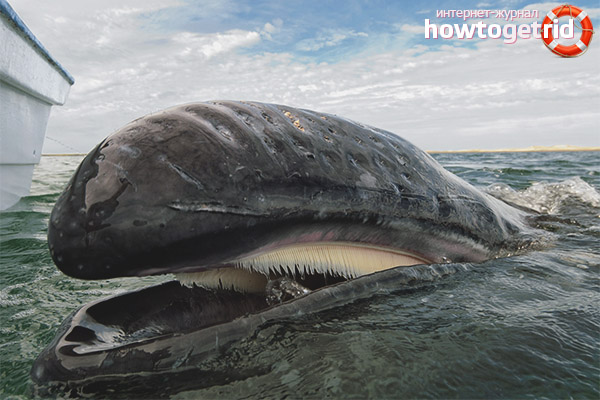The content of the article
The blue whale is an animal known all over the world as the largest marine inhabitant. Dimensions of adult individuals in length can reach 30 meters. Interestingly, in this species, females are traditionally larger and can bypass themselves in length by as much as 10 meters. In the 20th century, blue whales were actively exterminated as a result of commercial fishing. For this reason, their population has been greatly reduced. However, a ban on the destruction of blue whales was later introduced, due to which the number of these animals began to increase markedly.
Appearance characteristic
The blue whale, despite its name, still does not have a completely blue tint. Its upper part is rather motley and consists of a mixture of gray and blue colors.From below, this sea dweller, as a rule, has a light gray shade or a yellow-white color. The yellow color in the abdominal area of the whale is attached to the microscopic size of the algae, which are located on it as growths. These algae are called diatoms. The main distribution of plants received in the ocean waters of rather low temperature.
To date, according to official sources, the largest individual ever caught is a female whale with a length of 23.58 meters. The mass of such marine creatures may well reach 200 tons. To understand how this is a huge weight, you can compare it with the weight of an elephant, which is 7.5 tons. Surprise is caused also by the sizes of heart of this sea inhabitant which are identical to the sizes of the car. The beating of such a device can be heard even over three kilometers. There are varieties of blue whales, for example, pygmy whales. They differ from their relatives by a slightly more modest size, such individuals are about three meters less in length than other species of blue whales.
Blue whales can also be attributed to the animals that emit the loudest sounds.The power and volume of the sounds they make reaches 188 decibels. This volume exceeds even the loudness of the reactor, which is only 140 decibels. Representatives of the species can hear their fellows at a great distance - up to 1,500 kilometers.
Blue Whale Communication
Blue whales spend the main period of life alone, traveling across the sea. Sometimes they are combined into small groups of 2-3 individuals. Large flocks of about 50-60 whales are traditionally found in places where there is a large accumulation of food.
It should be borne in mind that the whale has the loudest voice of all animals. The sounds that emit a blue whale spread over many kilometers in deep water due to their low frequency. Whales can safely communicate with their relatives, hundreds and even thousands of miles away. For this reason, seemingly swimming in proud loneliness is not really such.
The diet of the blue sea creatures
The whales feed, plunging into the sea to a depth of approximately 100 meters. At one time, the whale's stomach can hold up to a ton of krill. The whale sinks this way approximately every 15-20 minutes. During summer feeding each individual takes up to 4 tons of krill daily.
In the mouth of the animal is placed the famous whalebone mustache, which is a black cornified plate, placed at the top of the sky and hanging down. On each side there are about 400 such records. The length of each varies from 50 to 100 centimeters. “Whalebone” is necessary for an animal, first of all, as a kind of filter, with the help of which the whale eliminates water and krill. When it enters the mouth, water comes out through the plates, but the whale swallows the rest of the food.
Blue Whales Livestock and Breeding
Cetacean females bring one calf every two to three years. To date, this rate of population addition exceeds the mortality rate due to the ongoing whale hunting.
Newborn whales are the largest calves on the planet. Only born kiten has a body length of up to 8 meters, and a weight of up to 4 tons.The female carries a baby for a year. Traditionally, only one kitten is born. A person can be very surprised by the growth rate of small whales. Every day, the cub becomes larger by 90 kilograms. An adult is a whale that has reached the age of 7-8 months. During this period, the animal already reaches 15 meters in length and begins to learn to swim without the help of adults. Whales become mature in different ways, it usually occurs between the ages of 5 and 10 years.
Blue whales are also famous for their highest growth rate. In just one year, the size of the tissues of this animal becomes larger by several billion times.
Blue whales have no teeth, like most cetaceans. For this reason, it is extremely difficult for scientists to determine how old an individual is. The average number of years that blue whales usually live is today considered to be 50 years old. Some members of the species are able to live much longer, up to about 90 years. There is an absolute record - the whale, who lived 110 years.
Whale Destruction Process
Before active hunting began on blue whales, the population of these animals significantly exceeded 250 thousand individuals.In the 20th century, the active extermination of individuals of this species began, as a result of which blue whales were almost completely destroyed. From 1904 to 1967, about 350 thousand individuals were destroyed, and this is only in the southern hemisphere. A large number of individuals were killed, including by the Soviet whalers in the 60-70s of the 20th century.
The most prominent in the last century was the year 1931, when the real flowering of whaling was observed. In just one season, nearly 30 thousand blue whales were destroyed. Only in 1967 the situation began to change. At this time, people from all over the world began to draw attention to the problem of the extermination of this species, after which the hunt for the largest marine creatures was prohibited.
Prevalence in our time
Today, blue whales are found all over the world. Their habitats are the world's oceans, except for the Arctic. Blue whales are the rarest species of cetaceans found today. So far, scientists can not reliably determine the population of the species. It is believed that today in the world about 10-25 thousand individuals.
One of the largest populations is the group of whales that lives in the Pacific Ocean, in its northern part, not far from California.The group has about 2 thousand individuals, and the number of this population increases very quickly, giving hope for an increase in the number of cetaceans in general.
Pygmy whales as well as dwarf whales are most common in the Indian Ocean. As a result of recent studies, it was found that these species of whales are found, including in other parts of our planet.
Blue whales live mainly in deep ocean waters. In the summer, these animals travel towards the poles, where the water temperature is slightly lower than in other places. In the winter period, whales, on the contrary, return back to the equator in warmer waters for reproduction.
Since the seasons in different hemispheres pass at completely different times, directly opposite to each other, representatives of different populations living on opposite sides of the equator are not in communication with each other.
What is dangerous for whales?
- Filling ocean waters with various chemicals.
- High probability of whales colliding with ships, as well as the danger of entangling individuals in fishing gear.
- Imbalance of sound in nature, which is dangerous for animals because they can not find a mate.
- Loss of permanent location and habitat.
A very dangerous moment for the whales is climate change. The fact is that a serious increase in temperature can make the water more acidic, as a result of which the number of krill, which is the basis of the diet for blue whales, may decrease.
Video: Blue Whale (Balaenoptera musculus)













To send